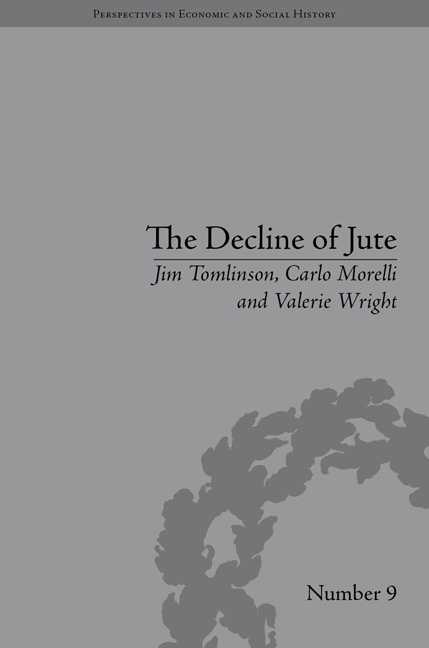Book contents
- Frontmatter
- CONTENTS
- Dedication
- Acknowledgements
- Abbreviations
- List of Figures and Tables
- Introduction
- 1 The Story up to 1939
- 2 De-Globalization and Decline, 1939–99
- 3 The Industry and its Workforce
- 4 Defending the Domestic Industry
- 5 Firms’ Responses to the Decline of the Industry
- 6 Influencing Government
- 7 The Decline of Jute and the Economic Health of Dundee
- Conclusions
- Notes
- Works Cited
- Index
4 - Defending the Domestic Industry
- Frontmatter
- CONTENTS
- Dedication
- Acknowledgements
- Abbreviations
- List of Figures and Tables
- Introduction
- 1 The Story up to 1939
- 2 De-Globalization and Decline, 1939–99
- 3 The Industry and its Workforce
- 4 Defending the Domestic Industry
- 5 Firms’ Responses to the Decline of the Industry
- 6 Influencing Government
- 7 The Decline of Jute and the Economic Health of Dundee
- Conclusions
- Notes
- Works Cited
- Index
Summary
The historiography of the jute industry discussed in Chapter 1 identified the era marking the end of the nineteenth century through to the First World War as the high point for the industry. This historiography faces a paradox; as an industry of the first industrial revolution, one in which technological change was limited or transferable between competitors, and an industry that saw rapid international competition leading to mass unemployment in the 1930s, it is quite remarkable that jute in Dundee not only continued but thrived into the post-war years. The explanation for the longevity of the jute industry requires a detailed explanation. A significant part of that explanation, as this chapter seeks to demonstrate, lies with the ability of the industry to successfully regulate market conditions. The invisible hand of market forces was partly displaced by the visible hand of firm level co-ordination and government regulation of competition and prices. In Chapter 3 we highlighted the degree to which the industry collectively managed labour supply, labour costs and the labour process. As this chapter now examines, management of the industry on a collective basis extended further than simply the question of labour and extended into all aspects of its commercial relationships. That collective approach included co-operation and regulation both vertically between firms within the supply chain and horizontally between competitors within each sector of the industry. Industry regulation thus played a significant role in a range of areas that are essential to understanding the longevity of the industry after 1945.
- Type
- Chapter
- Information
- The Decline of JuteManaging Industrial Change, pp. 65 - 92Publisher: Pickering & ChattoFirst published in: 2014



